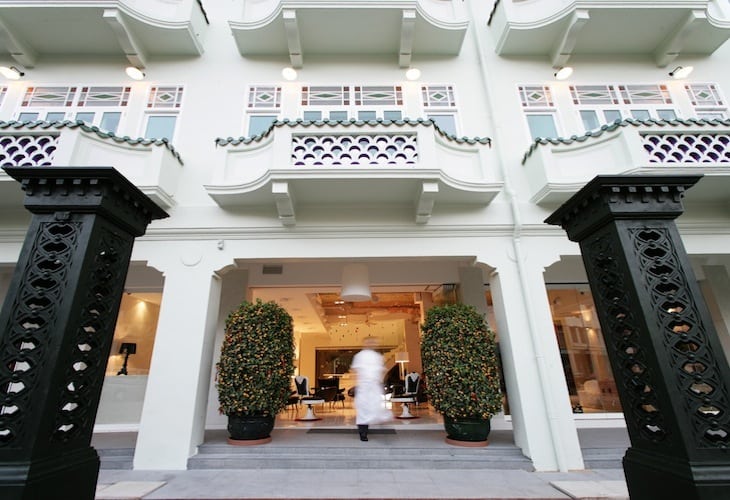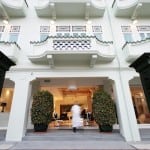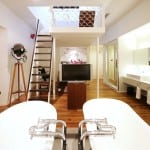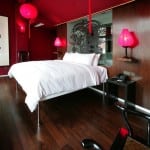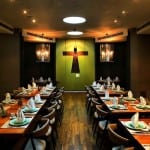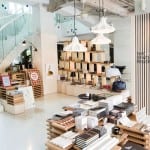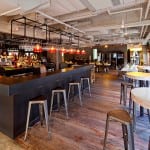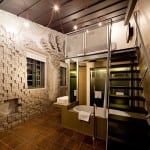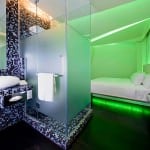Skift Take
Young ex-lawyer Loh Lik Peng is eviscerating Singapore's staid image with some of Asia's most creative, community-minded boutique hotels.
- New Majestic Hotel exterior.
- New Majestic Hotel room.
- Loh Lik Peng of Unlisted Collection.
- New Majestic Hotel room.
- New Majestic restaurant.
- The Space Program shop.
- The Space Program shop.
- Wanderlust Hotel interior.
- Wanderlust Hotel room.
- Wanderlust Cocotte bar.
- Wanderlust Hotel bathroom.
- Wanderlust Hotel room.
Founder of the Unlisted Collection hotel group based in Singapore, Loh Lik Peng has been quietly building one of the world’s most exciting hotel portfolios over the last 10 years. He’s also having a lot of fun doing it, because he knows what it’s like not to.
During the late 1990s, “Mr. Loh” was a corporate lawyer overseeing the foreclosure of many Singaporean commercial buildings during the Asian financial crisis. It was depressing and demoralizing, day after day, shutting down businesses and boarding up buildings as if they were a growing cancer spreading throughout his city.
One day Loh came across a particularly interesting building in Singapore’s red light district in Chinatown. It was surrounded by the city’s famous “shophouses”—narrow heritage homes consisting of a business at street level and domicile above—and nobody wanted it. So he decided to buy it himself and convert it into Hotel 1929, even though he had no idea how to actually run a hotel.
Loh followed that with the New Majestic Hotel just down the street, and Wanderlust Hotel in the Little India district. Then he took his show on the road, opening The Waterhouse at South Bund in Shanghai’s old docklands, and three more boutique hotels in London, including the new One Leicester Street in Chinatown last spring. Sydney is next.
Loh has become the darling of the travel industry by transforming forgotten buildings in underserved neighborhoods into ultra hip hotels with well regarded restaurants and a complete lack of pretense. Although, it wasn’t until Town Hall Hotel in London won its first Michelin star that Loh, unassuming and down-to-earth, thought he might have a knack for this hotel thing.
“The fact that we were able to make it work gave me a lot of confidence,” he says in this recent Canon Singapore interview. “After that, I thought ‘wow,’ if I can make this work, I guess we’ve got something to offer.”
In Singapore this past summer, the first thing I noticed upon entering the hotel lobbies was the assortment of vintage barber chairs. Loh collects them. At the 29-room Wanderlust, there’s also a Frank Gehry sofa and Trent Jansen chairs anchoring the raw concrete space.
Upstairs, a different local design firm created each of the guest room floors, like Phunk Studio’s minimalist technicolor studios on the second level. On the top floor, fFurious designed a series of loft suites featuring a spaceship in one and a treehouse in another.
At the 30-room New Majestic, the lobby is also filled with barber chairs and an eclectic collection of mid-century furniture. Items include a hot pink opposing loveseat, numerous Hollywood kleig lights and a retro bicycle rickshaw with colorful quilted upholstery. In the restaurant, porthole windows in the ceiling look up into the pool overhead.
The Space Program
Here’s where things get interesting. Conceptualized by Foreign Policy Design Group, “The Space Program” is a unique pop-up lobby concept at New Majestic that is part museum, part retail and part installation. The local art, books, music, fashion and home furnishings are curated to celebrate a new culture of creative spirit in Singapore. They create tangible value out of an underutilized urban space through an artistic lens, and they promote local artists and small businesses overlooked by the casual tourist.
“At Foreign Policy, we approach all our projects with three aspects in mind: design, intellect and contemporary culture,” says Yah-Leng Yu, ambassador of design. “We want to tell the story that we have designers, artists, writers and makers in Singapore; we have progressed as a cultural society.”
She explains that this project is ambitious because of the installation’s role as both art and basically a hotel gift shop, calling it an “architectural, artistic and curatorial process” wrapped up in one. This is also the only place a tourist will likely come across a set of Democratic Society plates from SuperMama, designed in collaboration with a Japanese porcelain master.
Yah-Leng adds that Foreign Policy is seeking international hotel partners to expand the project, based on its success at New Majestic.
To learn more about the Unlisted Collection, I reached out to Mr. Loh and Mae Noor, head of branding and communications. Below is a transcript of our correspondence.
Going Local with Loh Lik Peng
Greg Oates: Mr. Loh, you seem to be having a lot of fun recreating these wonderful hotels. How and why do you choose a particular building? And are you collaborating in the design process?
Loh Lik Peng: I choose my projects when I fall in love with the building. They are often in unconventional areas and I think what matters to me is not so much the location but the building. It’s really lovely to be able to work with and preserve a slice of history and I think it’s one of the privileges of doing my job! You can never quite recreate the sense of time and age built into these old buildings and I like that I get to touch and feel history for real. I always try to imagine the stories they have to tell and the lives they have seen and touched.
Design is always a collaborative process for me so I always work with architects and interior designers to achieve something original and fun. It’s very seldom that I give a detailed brief to the designers so they almost always work from a blank canvas at first, which is why none of my projects have a signature look as such. The only personal touch you will often see in my projects is that they are almost always in conservation buildings (which I love) and often have a vintage barber or dentist chair, which I collect.
I try to make sure the design is relevant to the building, the location and the country we operate in. We try to be as local as possible and we try to ensure our neighbours are proud of having us there. To me this is very important so we try to use local designers and local artists in all our projects.
Greg Oates: Have Wanderlust and New Majestic helped bring new attention to Little India and Chinatown for travelers who may not have visited before?
Loh Lik Peng: Well I opened Hotel 1929 and Restaurant Ember in early 2003 and New Majestic Hotel and Majestic Restaurant in early 2006, so I was an early entrant to the area. I love the area and personally for me it’s one of the last untouched bits of Chinatown where you can still get the unadulterated local flavours. When I first moved, brothels were still a big part of the area. The area has cleaned up quite well. I miss some of the local denizens that have since moved on, but it is still a very interesting and local neighbourhood and all the good local eateries are still there. I hope they’ll preserve the existing structures of the area, retain the charm, old-worldliness and authenticity of the neighbourhood.
For Little India, we’ve definitely brought a different flavour to the neighbourhood. Before this, Little India had a reputation for cheap accommodation and backpacker inns. With Wanderlust we’ve hopefully injected a little bit more fun and more interesting choices.
People are after the experience and authenticity now rather than the highest thread count or most marble. It’s really about having something that you can savour after the actual trip and store it away as an experience.
Greg Oates: In the US, there are lingering perceptions that Singapore is still somewhat staid in terms of culture. Do you see a new energy among Singapore’s youth to change those perceptions?
Loh Lik Peng: Now in Singapore, at every level, creativity is being encouraged and nurtured. We have specialist art schools and strong support from the government for the creative industries. Also, the hospitality scene in Singapore has changed beyond recognition in the last 10 years. We now have an unrivaled range of restaurants, bars and nightspots, and a very diverse set of attractions and activities to suit everyone.
Mae Noor ‘Gets Down’ With the Locals
Greg Oates: Mae, the Unlisted Collection hotels are unlike anywhere else in Singapore. How do you describe the overall design vision?
Mae Noor: I would say it’s eccentric, a mish-mash of vintage and designer pieces that somehow go really well together, giving our lobbies this raw and edgy feeling to it. We don’t “plan” where to specifically place them. Everytime Mr. Loh comes back with new pieces, we sort of just stand in the lobby for a good 30 minutes and look around like, ‘Now what do we do with them?’ We move them around the three properties until we feel they have found a home.
As for the general design elements of the hotels, none of the designers are interior designers or have ever designed a hotel space. They are graphic designers, branding agencies, and we even have fashion designers, a theatre director and various other disciplines. They are used to working with an entirely different canvas, and we love that the ideas they brought to the table are really crazy and out of this world. It is of course about studying design feasibility and scaling down to make sure at the end of the day we remember that this has to be a practical living space. So far this has worked really well for us.
Greg Oates: How would you describe your guests? What are they interested in?
Mae Noor: They used to come from creative backgrounds, like the ad agencies or the entertainment companies—people ‘in the know’—largely because they are more open and exposed to the concept of boutique hotels. But in the past couple of years or so, we are seeing more and more of them come from IT companies, even pharmaceutical! There has been a lot of exposure for boutique hotels, and mostly, it evokes curiosity.
They are always asking, hmmm, what is this boutique hotel? How is it different from other hotels? They are curious to find out. I know people usually think that corporate guests are boring. But really, we have repeat guests who, at the time of booking, say ‘surprise me’ when we ask for their preferred room. We love that we are able to give them the options and that they are able to have as much fun as we do!
Greg Oates: How are Chinatown and Little India evolving?
Mae Noor: I must say that the Gen-Y invasion, bringing with them the vibrancy of youth and well-travelled knowledge into these neighbourhoods, have really lifted these otherwise old, kitschy places and given them a new lease of life. We see boutique coffee places popping up, local designers setting up shop, design agencies—and suddenly everyone’s interested in Chinatown, Little India, Tiong Bahru and Arab Street once again. It’s now the cool place to be seen…. At the same time, we stumble into these little gems on the street that we would never have otherwise known.
What I like is that we are always respectful of the cultures and people who have been in the area from way back when. That we are not saying, look we are new and we are here to take over. It’s always about integrating both the element of old and new.
Travellers are so well-read now, they have information at the touch of a screen. They no longer come to us and ask for directions to Orchard Road. Now they ask, ‘So Mae, what do you usually do over the weekend, where do you go?’ They want to get down with the locals. They want to know where we go for the best Bak Chor Mee, and they know that the best people to ask are the locals themselves.
We usually give out these little booklets we make in-house for recommendations on what to See, Eat, Do, Buy around the area of the hotels. Every guest is given one at check-in. These recommendations are based on what we—the team and staff—have agreed on. You know what’s the best part? We see a lot of local guests especially over the weekend for staycations. These folks who are born and bred in Singapore, they have told me that even they feel like tourists all over again.
Greg Oates covers hospitality trends and next generation hotels. He has participated in 1,000+ hotel site inspections in over 50 countries.
Have a confidential tip for Skift? Get in touch
Tags: architecture, singapore
